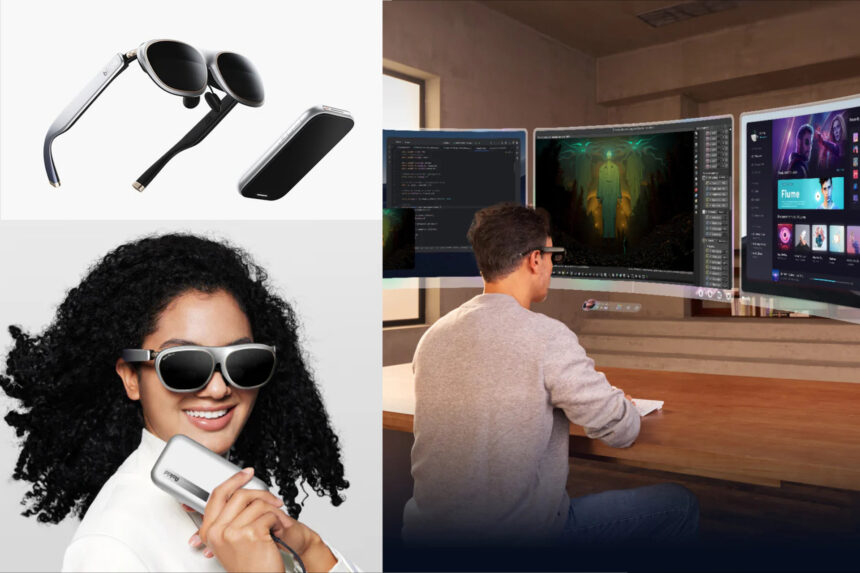Rokid AR Lite is a product bundle that includes upgraded smart glasses and a handheld compute module that runs Android, eliminating the need for a phone.
Rokid launched a Kickstarter campaign in April for two new products designed to work together to create a spatial computing experience in a pocket-sized package. Rokid far surpassed the $20,000 goal, reaching over $900,000 in pledges with over 1,700 backers. Now that the project is fully funded, it’s time for an update on this intriguing product.
Rokid AR Lite details
The included Rokid Max 2 smart glasses have an impressive 50-degree FOV, 600-nits of brightness, and a resolution of up to 1920×1200 pixels at up to 120 Hz. Like the previous version, vision correction dials allow up to 6 diopters of adjustment for myopia. Speakers are built-into the earpieces.
A motion sensor detects head-movement so screens can remain in place when you turn your head. Despite the amount of technology in these smart glasses, Rokid managed to keep the weight low at 75 g.

The Rokid Station 2 is a pocket-size compute module based on Qualcomm’s Snapdragon 6 Gen 1 processor, 8 GB of memory, 128 GB of storage, a 5,000 mAh battery, two USB-C ports, and Wi-Fi 6. That’s how the Rokid AR Lite can offer features that a phone app can’t match. It sounds similar to Xreal’s new Beam Pro.
The device can display up to three Android apps or browser windows side-by-side. It’s surface acts as a touchpad so you can pinch to zoom in on photos and move a cursor to navigate on the virtual three-screen interface.
You can preorder Rokid AR Lite for $499 (regularly $749) at the Kickstarter link below. Rokid estimates shipping to begin in September 2024.
Rokid AR Lite vs previous generation
The Rokid Max 2 smart glasses are an upgraded version of the popular Rokid Max model released in 2023. The new model matches all the specifications of the original with improved flexible earpieces, providing a more comfortable fit for everyone.
Rokid also claims the Max 2 has the world’s first software-based IPD adjustment for smart glasses, called Intelligent Pupil Adaptation. The 53 to 75 mm range should make the displays sharper for anyone that had trouble with earlier models.

In my review of Rokid Max, I also covered the original Rokid Station, which is more of an entertainment device with an Android TV interface and access to most popular streaming services and a few games. Rokid AR Lite should also excel at entertainment, and it introduces a movement mode to stabilize screen motion when traveling.
Rokid Station 2 is much more versatile, running Rokid’s YodaOS, a variant of Android. Rokid estimates “more than 90% of Android applications run without issues.” While many Android apps will work with the Rokid Station 2, some require Google Mobile Services.
The new Rokid Station 2, which is responsible for the AR Lite’s spatial computing features can be ordered separately for $299 and will be compatible with the original Rokid Max smart glasses. Rokid Station 2 can also pair with a Bluetooth keyboard for greater productivity.
My take on Rokid AR Lite
I found the Rokid Max to be among the best smart glasses available and expect the Max 2 to be even better. I enjoyed using the original Rokid Station, but prefer to watch videos with my wife, so I found I didn’t use it as much as I expected.
The Rokid AR Lite is a more compelling combination for me, since I could use it for work. I like that it can be used as a standalone solution without draining my phone battery.
It’s important to note that the Rokid AR Lite smart glasses aren’t AR glasses that can map your room and track your hands. The Rokid AR Lite is a lower-cost version of the Rokid AR Studio which launched only in China. While AR Studio included hand-tracking, AR Lite relies on the Rokid Station 2’s touchpad.
The Rokid’s AR Lite sounds intriguing, but we haven’t had a chance to try this new product. When review samples become available, we’ll share our hands-on experience.
Source: Mixed News






